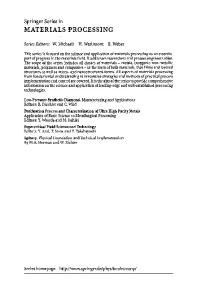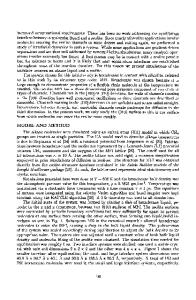Molecular-Dynamics Simulations of Polymer Surfaces and Interfaces
- PDF / 5,024,384 Bytes
- 6 Pages / 576 x 777.6 pts Page_size
- 106 Downloads / 478 Views
MRS BULLETIN/JANUARY 1997
number of such chains are constructed and put in a virtual system having the desired boundary conditions—that is, periodic, antiperiodic, or a wall. In an MD simulation, the time evolution of the coordinates of all chains is resolved through Newton's equation of motion (EOM).5 The softness and the stickiness of the beads, which we call mers, are set by the interaction potential. The motion of the chains is coupled with a heat bath, acting through a weak stochastic force W and a corresponding viscous-damping force with friction coefficient F. Besides improving the diffusion of the system in phase space, this coupling has the practical advantage of stabilizing the numerical calculation. Including these terms, the EOM of mer i at position r, is (1)
els can more easily represent polymer branches such as those in star-branched polymers, crosslinked polymer networks, or simple branched polymers. One can also study the effects of volume difference between species, more realistic, longer range potentials, and the effects of shear. For systems with interfaces, CS models have one more advantage: Besides their inherent spatial isotropy, they offer a simple way of obtaining the surface tension from the measured pressure tensor.3 Once a CS approach has been chosen, one has then to decide on an efficient simulation algorithm. At the present time, principally two methods 4 exist for the simulation of systems at equilibrium—namely Monte Carlo (MC) and molecular dynamics (MD).1 Although both methods give similar results, they are conceptually and computationally very different. However since MD algorithms include the actual classical, internal dynamics, they also give direct access to the dynamical behavior of the system. Here we mostly concentrate on MD methods.
Model and Method The magnitude of the relevant length and time scales responsible for the macroscopic properties of polymeric systems allows one to use a simplified model for a polymer molecule. For a CS model, a convenient representation of a homopolymer consists of attaching N soft or hard spherical beads of mass m together to form a chain. The resulting object, representing one chain, has 3N spatial coordinates. In practice a large
The last term W,-(f) is a white noise having an average strength determined by temperature and the friction coefficient through the fluctuation-dissipation theorem. In the viscous drag term, F has to be carefully chosen to avoid overdamping so that the motion of the mers will be dominated by inertia. Finally the conservative-force term derives from a potential energy U that includes the following: the attractive potential holding adjacent mers along the same chain,6 an interaction potential acting between all the mers that is responsible for excluded volume effects, and finally any potential arising from the presence of walls. The interaction acting between mers is represented by an effective two-body potential, which is often truncated to a short cut-off distance rc since the number of interacting pairs increase
Data Loading...








